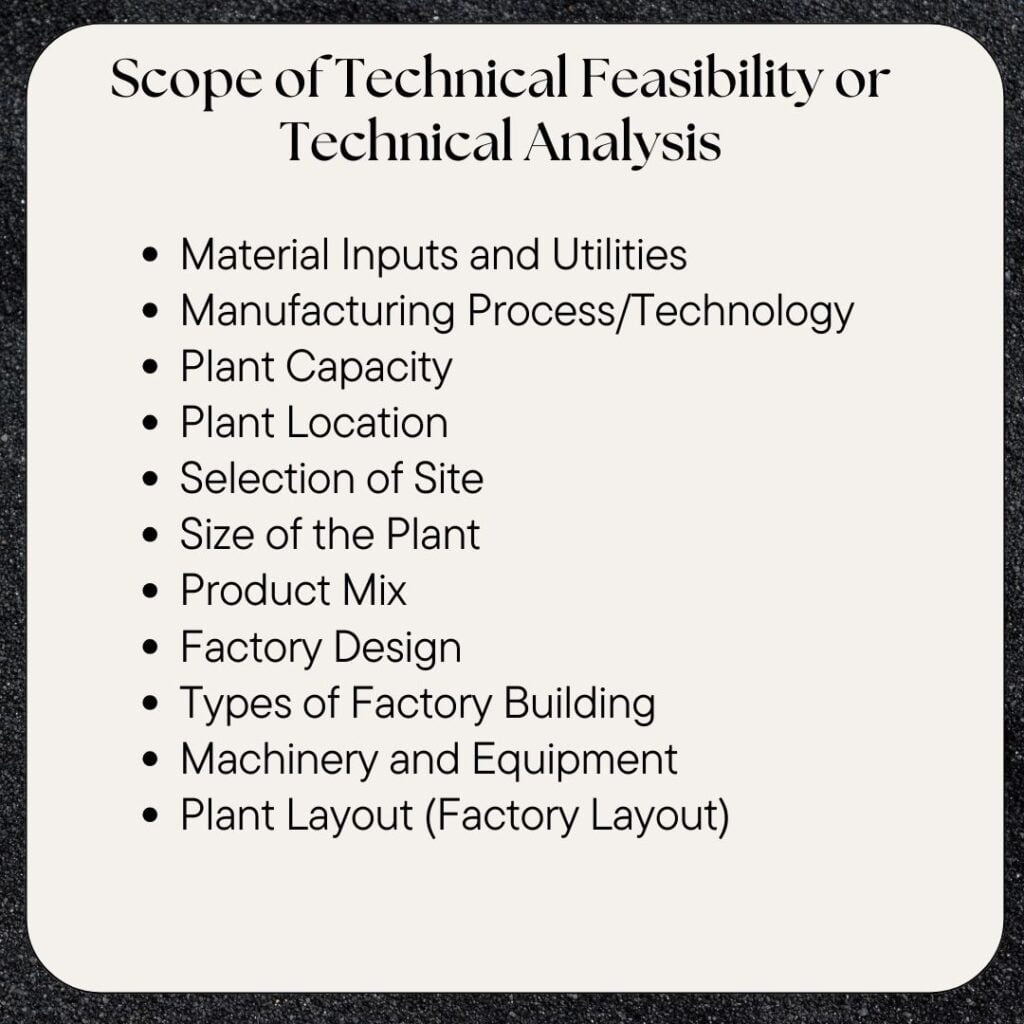Introduction
Trying to understand the meaning of technical analysis of a project is like trying to decode the secret formula for its triumph. It’s like setting off on a journey without a map – technical analysis acts as that guiding compass, leading project managers through the maze of complexities. But what exactly does technical analysis involve, and why is it so crucial in the world of project management?
Let’s dive into the meaning and importance of technical analysis, uncovering how it sets the foundation for making informed decisions, minimizing risks, and optimizing resources. In this article, we’ll unravel the many facets of technical analysis and its vital role in steering projects towards long-term success.
Technical Feasibility (or Technical Analysis)

It is crucial to conduct a technical analysis of a project to make sure that all the necessary physical facilities needed for production will be accessible. Additionally, this analysis helps in choosing the most suitable option to acquire these facilities. Other types of analysis are dependent and closely related to technical analysis.
Meaning of Technical Analysis of a Project (or Technical Feasibility)
Technical analysis involves studying the technical aspects of a project. The main goal of technical analysis is to evaluate the project’s technical strength. This means technical analysis is carried out to ascertain whether the project is technically sound and viable.
The project must succeed in the long run. Most technical features of the product are non-reversible. Therefore, any error of judgment at this stage regarding technical parameters may have far-reaching consequences on the project.
For Example:
Imagine a company excited to construct a solar power plant in a desert area. It’s important to carefully study the amount of sunlight the location gets all year round. By looking at past weather records and solar radiation maps, we can figure out if there’s enough sunlight for effective power production. It’s also crucial to think about how well the materials in the solar panels can hold up in tough desert conditions.
Without thorough technical analysis, the company could end up putting money into a project that seems good at first, but later find out that not enough sunlight or extreme temperatures are causing major problems with power generation, ultimately leading to the project failing.
Importance of Technical Analysis

Absolutely! Let’s explore the significance of technical analysis in the realm of project management:
Building a Strong Foundation for Decision-Making:
- Technical analysis serves as a sturdy base for making well-informed decisions throughout the project planning and execution phases.
- By thoroughly examining technical aspects, project managers can identify potential risks, evaluate feasibility, and allocate resources efficiently.
Mitigating Risks:
- By identifying potential technical risks early on, project managers can take proactive measures to manage them effectively.
- Technical analysis helps anticipate challenges related to materials, processes, or technology, enabling timely implementation of mitigation strategies.
Optimizing Resource Allocation:
- Efficient allocation of resources is crucial for the success of any project.
- Technical analysis guides decision-making regarding material sourcing, manufacturing processes, and plant capacity.
- By optimizing resources, project managers ensure cost-effectiveness and timely completion of the project.
Ensuring Quality Assurance:
- Technical analysis plays a vital role in ensuring that the project meets the required quality standards.
- By evaluating material properties, production methods, and technology, project managers can maintain the integrity of the final product.
Assessing Feasibility:
- Evaluating technical feasibility helps determine if the project can be executed successfully.
- Factors such as available technology, skilled workforce, and compatibility with existing infrastructure are taken into consideration during this assessment.
Adaptability and Flexibility:
- Technical analysis empowers project managers to adapt to changing circumstances.
- If a chosen technology becomes outdated, adjustments can be made to ensure the smooth continuity of the project.
Scope of Technical Feasibility or Technical Analysis
Let’s check the scope of Technical Analysis. Technical feasibility or analysis includes the study of the following.

1. Material Inputs and Utilities
Material inputs are required for the production of goods/services. Hence it is essential to the assess availability of materials, inputs, and utilities.
The availability of facilities, services, and other resources required for a project during the execution period and during the operation stage right from manufacturing to marketing should be considered.
Utilities include power, water, steam, fuel, material handling, waste removal, inspecting and testing facilities, storage, communication facilities, transport facilities, etc.
The examination to determine if a material is feasible should consider these factors:
- The amount and quality of raw materials that are accessible
- The elements that affect the availability of raw materials.
- Price elasticity of raw material
- Perishable time of raw material
Sustainable Material Sourcing and Waste Management are becoming more and more important in today’s world. Project managers are now giving priority to environmentally friendly practices.
There are a few key things to consider when it comes to sustainability in material sourcing.
- One of them is choosing materials that have minimal impact on the environment. This can include using recycled materials or materials that are biodegradable.
- Another important consideration is the supply chain. It’s important to source materials from suppliers who follow ethical and ecological standards. This ensures that the materials are being sourced sustainably.
- Waste reduction is also a crucial aspect of sustainability. Project managers should aim to minimize waste generation by implementing efficient processes and recycling initiatives.
By integrating sustainability into technical analysis, projects can contribute to a greener future. This means considering the environmental impact of material sourcing and waste management throughout the project.
There are also digital tools available to help with material management. One of them is Material Requirements Planning (MRP) systems. These systems calculate demand, lead times, and safety stock levels to optimize material procurement. This helps ensure that materials are available when they are needed.
Enterprise Resource Planning (ERP) software is another useful tool. It integrates material management with other business processes like finance, production, and inventory. This streamlines data flow improves decision-making, and enhances resource allocation.
Inventory management software is also important for sustainable material sourcing and waste management. It tracks material levels, reorder points, and consumption patterns. This allows for real-time monitoring and efficient inventory control.
The entrepreneur is required to plan the material requirements. Material requirement planning is undertaken to analyze the quality of material that would be required to ensure the smooth running of production. It would rely on the variables mentioned above regarding the availability of materials.
2. Manufacturing Process/Technology
Technology is all about using machines, tools, and equipment to make products in a factory. It’s like having the know-how to do things more efficiently. It’s how a company turns its raw materials into finished goods.
It’s all about using the right tools and knowledge to get the job done. For example, an automobile company uses technology to convert its raw materials into vehicles. Take another example.
Steel is produced using either the Bessemer method or the open hearth method. Cement can be produced using either the dry method or the wet method.
The decision on which method to use is based on various factors such as:
- Plant capacity
- Inputs
- Investment outlay
- Use by other units
- Product mix
- Latest developments
- Ease of absorption
- Cost
You can acquire the necessary technical knowledge from these resources:
- Foreign Collaborators
- Consultancy Organisations
- Machinery Suppliers
- Promoter’s knowledge and experience
- Recruitment of suitable technical personnel
- CSIR Labs and the National Research and Development Corporation (NRDC) are working together.
- Consultants (organizations and individuals)
Automation, Robotics, and AI play crucial roles in the manufacturing industry. Automation helps to streamline tasks, reduce errors, and boost efficiency. Robotics are used for complex tasks like welding and painting, while AI analyzes data and enhances production schedules.
3. Plant Capacity
The plant capacity is the maximum number of units that can be produced within a set timeframe. Plant capacity is also called production capacity.
While deciding the plant capacity, the following factors should be taken into consideration:
- Technological requirement
- Input constraints
- Investment cost
- Market conditions
- Resources of the firm
- Government policy
4. Plant Location
Plant location refers to a fairly broad area where the enterprise will be established like a city, industrial zone, or coastal area. The location of the project has to be decided judiciously and objectively. A wrong selection of location may cause difficulties in input requirements, non-availability of competent technical personnel, and the like.
The success of a project depends on the location, to a certain extent. Hence greater care should be taken while selecting the location.
When deciding on a plant location, proximity to markets and resources is crucial. Being close to major markets or distribution centers reduces distribution costs and shipping time, making it cost-efficient. Customers prefer purchasing from nearby sources for convenience, especially for perishable goods.
Access to raw materials, skilled labor, energy sources, and water supply is essential for production efficiency. Considering renewable energy sources like solar, wind, or hydro can lead to cost savings and environmental benefits, aligning with sustainability goals.
Assessing risks related to natural disasters and implementing mitigation measures is crucial for business continuity. Choosing locations with lower disaster risks ensures plant resilience and long-term success.
5. Selection of Site
The terms ‘location’ and ‘site’ are different. Location refers to a fairly broad area like a city, an industrial zone, or a coastal area. But, a site refers to a specific piece of land where the project would be set up.
Once the broad location is selected, attention should be given to the selection of a specific site. We need to think about and assess two or three different places as options. We should consider how much the land costs and how much it will cost to prepare and develop the site.
6. Size of the Plant
The size of a project plays a significant role in determining its efficiency and profitability. The plant’s size is determined by various factors such as the manufacturing process, the availability of raw materials, the capital investment needed, and the size of the market.
Generally, a large-sized unit is more economical than a small-sized unit. But if the establishment of a large unit needs heavy capital investment the market demand is not sufficient for production at such a level or sufficient raw material is not available for a large unit, it may be better to set up a plant of small size.
The size of the plant should be decided to keep in view the following factors:
- Availability of raw materials and power
- Technology/process to be adopted
- Size of the market
- Size of the plant and machinery
- Capital investment required
7. Product Mix
The product mix or product range is decided according to market requirements. A firm’s product mix encompasses all the products it has available for sale. The total count of items across all product categories is what we refer to as the total number of products in all product lines.
The product line refers to the number of brands or similar products within a specific product category.
Certain items will have to be produced in different sizes and quality to suit different customers. For example, the production of shoes, readymade garments, etc. will have to be done in different sizes and quality.
Sometimes a slight difference in quality may help not only in increasing sales but also in raising profits by having a higher margin of profit on higher-quality goods.
Selection of a potentially profitable product is the first step towards a successful venture. The product should:
- Serve the immediate need,
- Serve the existing market in which demand exceeds supply,
- Compare with a product that is alike in terms of design, cost, and usefulness.
The factors that influence the selection of the product mix include:
- profits and sales growth potential,
- stability in sales,
- better customer service,
- utilization of available know-how,
- cost reduction,
- better capacity utilization.
Let’s explore the trends of personalization and customization in product design and their impact on production processes, along with the influence of e-commerce on product mix decisions:
- Personalization and customization trends involve tailoring products and services to individual users’ needs and preferences, as well as allowing highly variant products at costs close to mass production.
- The implications of personalization and customization include reduced interaction efforts for customers, the serendipity effect of recommending relevant products, and increased sales through meeting individual preferences.
- Automation, robotics, and AI in manufacturing streamline repetitive tasks, handle intricate tasks, analyze data, predict maintenance needs, and optimize production schedules.
- Additive manufacturing, or 3D printing, offers design freedom for complex geometries and customized designs, reduces waste by depositing material only where needed, and accelerates product development through rapid prototyping.
- The use of additive manufacturing also brings supply chain disruption by reducing reliance on global supply chains, but it faces challenges such as material limitations, scalability, and post-processing requirements.
- E-commerce has a significant influence on product mix decisions by adopting a market-centric approach, allowing real-time adjustments based on demand, facilitating the selling of niche products, and providing data-driven insights through analytics.
8. Factory Design
Once an entrepreneur has taken the decision to set up a factory and selected the location and site for it, the next step is to plan and organize the facilities to be used in the factory.
Factory design is all about how a building is set up, where the machines and equipment are placed, and what service facilities, lighting, heating, and ventilation are provided.in the building. Factory design comprises the layout of the building (building design) and the layout of the factory.
When planning a factory, it is important to take into account the following factors.
- Location
- Nature of the manufacturing process
- Plant layout
- Smoothness in operation
- Service facilities
- Material Handling
- Cost of construction of the building
- Future expansion
- Nature of product
- Appearance
Smart manufacturing also referred to as smart factories, is completely transforming the way companies function by incorporating cutting-edge technologies into their manufacturing processes. Let’s delve into the essential elements of smart factories and the influence they have.
- The Industrial Internet of Things (IIoT) connects machinery, tools, and sensors to collect and share data, facilitating equipment management, maintenance, and communication in smart factories.
- AI conducts real-time data analysis efficiently by processing inputs from sensors and IoT devices to identify patterns and detect anomalies and equipment defects proactively.
- Predictive analytics techniques help optimize production workflows by identifying inefficiencies, bottlenecks, and quality issues through historical data analysis.
- Smart factories benefit from agility, resource optimization, quality assurance, and cost reduction through predictive maintenance, real-time monitoring, and informed decision-making based on real-time insights.
9. Types of Factory Building
The factory building should be designed and built to protect the property and workers. The factory building should provide a pleasant and comfortable working environment. It should provide for efficient operation of the plant so that the cost of operation can be minimized. The design should be made to assist in the smooth and productive functioning of the plant.
While designing and constructing the factory building, the following factors should be
taken into consideration:
- Plant location
- Plant layout
- Material Handling
- Product and equipment
- Provision of expansion
- Lighting and ventilation
- Safety and Security
- Employee facilities
- Flexibility
The other factors include power supply, internal transportation, and communication facilities, control to be exercised on men and materials, etc.
10. Machinery and Equipment
The need for machinery and equipment depends on the production technology and the size of the plant. It is also affected by the specific project. In industries focused on processes, such as a petrochemical plant, the machinery and equipment must be suitable for ensuring smooth operation at each stage.
11. Plant Layout (Factory Layout)
The efficiency of a manufacturing operation also depends on the layout of the plant and machinery. A well-designed plant layout can help cut down on manufacturing expenses by saving both money and time. Plant layout involves organizing the machines, equipment, and other physical facilities on the factory premises.
It can be described as a method of strategically placing machines, processes, and plant services within the factory to achieve the highest possible production of top-notch quality goods at the lowest possible total cost of production”.
When planning the design, it’s important to take into account the following factors:
- Nature of industry
- Volume of production
- Type of product d) Location
- Material Handling
- Type of equipment
- Factory building
- Service facilities
- Lighting and ventilation
Challenges and Strategies
Certainly! Let’s delve into the challenges and strategies related to technical analysis in project management:

Data Quality and Availability:
Challenge: Technical analysis heavily relies on historical data. If the data is not complete, accurate, or biased, it can result in flawed conclusions.
Strategy: To ensure data quality, it is important to validate sources, clean the data, and address any missing values. If historical data is insufficient, consider using alternative data sources.
Subjectivity and Interpretation:
Challenge: Technical analysis involves interpreting charts, patterns, and indicators. Different analysts may interpret the same data in different ways.
Strategy: To minimize subjectivity, it is important to standardize analysis methods and provide clear guidelines. Encouraging collaboration among analysts can also help in reducing subjective interpretations.
Overfitting and Curve Fitting:
Challenge: Overfitting occurs when a model fits the noise in the data rather than the actual trend. This can lead to inaccurate predictions.
Strategy: To avoid overfitting, it is recommended to use robust statistical techniques, and cross-validation, and avoid excessive complexity. Focusing on relevant features is also crucial.
Market Noise and Random Fluctuations:
Challenge: Markets are influenced by various factors, such as news, sentiment, and external events. These short-term fluctuations can make it difficult to identify long-term trends.
Strategy: To filter out noise, it is advisable to use moving averages, trendlines, and longer timeframes. By focusing on the bigger picture, one can better understand the underlying trends.
Changing Market Conditions:
Challenge: Markets evolve due to economic, political, and technological changes. Technical patterns that were effective in the past may no longer work.
Strategy: To tackle changing market conditions, it is important to stay updated, adapt to the new conditions, and combine technical analysis with fundamental analysis.
False Signals and Whipsaws:
Challenge: Technical indicators generate signals, but not all of them are accurate. False signals can lead to poor decision-making.
Strategy: To mitigate the risk of false signals, it is recommended to use multiple indicators for confirmation. Additionally, implementing risk management techniques can help limit losses during whipsaws.
Emotional Bias:
Challenge: Traders and analysts sometimes become emotionally connected to their positions, which can result in biased interpretations.
Strategy: Stay focused and disciplined, adhere to predetermined rules, and steer clear of making decisions based on emotions.
Lack of Predictive Power:
Challenge: Technical analysis cannot accurately forecast future events. Instead, it offers probabilities based on past patterns.
Strategy: To gain a comprehensive perspective, integrate technical analysis with other tools such as fundamental analysis and sentiment analysis.
Conclusion
In conclusion, I discuss the meaning of technical analysis of a project. Technical analysis plays a vital role in the success of any project. It gives us valuable insights, helps us make informed decisions, and ensures that resources are allocated efficiently.
In today’s ever-changing world, being proficient in technical analysis is essential to stay ahead of the competition and achieve long-term growth. Embrace its potential to foster innovation and effectively navigate through challenges.











2 Reviews